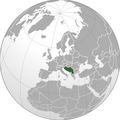Lebanon–Yugoslavia_relations
Lebanon–Yugoslavia relations
Bilateral relations
Lebanon–Yugoslavia relations were historical foreign relations between Lebanon and now split-up Socialist Federal Republic of Yugoslavia. Both countries self-identified with the wider Mediterranean region and shared membership in the Non-Aligned Movement. Formal bilateral relations between Lebanon and Yugoslavia were established in 1946.[1] Lebanon participated at the 1961 First Conference of Heads of State or Government of the Non-Aligned Movement in Belgrade.[1] Both countries experienced significant instabilities and conflicts[2] with weak central authorities which in Yugoslav case led to complete dismemberment of federal institutions and violent breakup of the state. Instability in both countries led to the establishment of special courts; the Special Tribunal for Lebanon and International Criminal Tribunal for the former Yugoslavia.[3]
This article needs additional citations for verification. (February 2021) |

